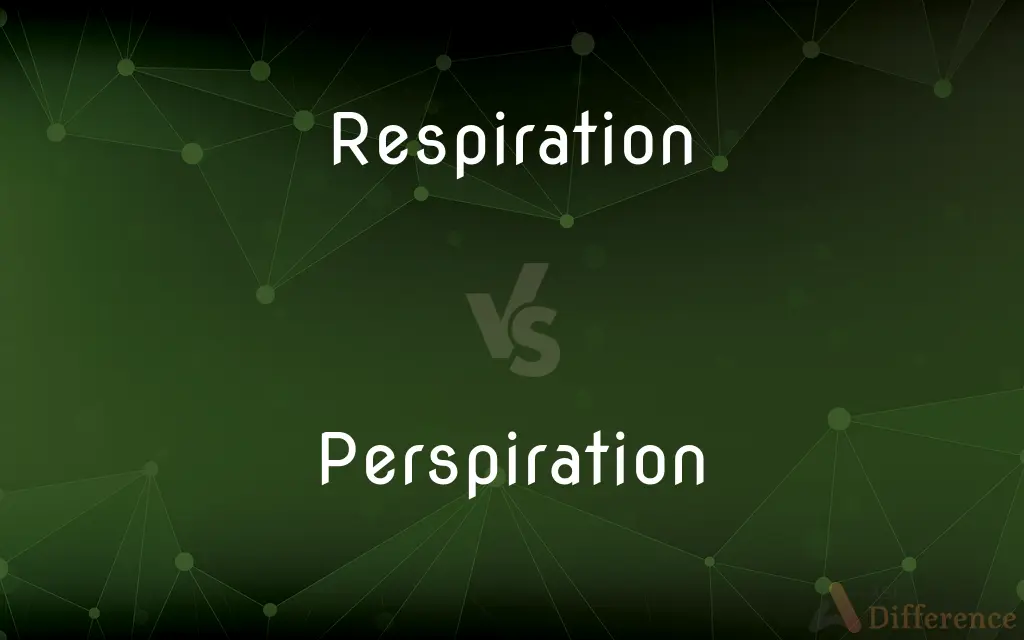Respiration vs. Perspiration — What's the Difference?
By Tayyaba Rehman — Published on October 18, 2023
Respiration is the process of inhaling and exhaling air, while perspiration is the process of sweating to regulate body temperature.

Difference Between Respiration and Perspiration
Table of Contents
ADVERTISEMENT
Key Differences
Respiration, at its core, refers to the process by which organisms inhale and exhale, absorbing oxygen and releasing carbon dioxide. Contrastingly, perspiration is the body’s mechanism of secreting sweat through the skin’s pores, a method principally engaged in managing and maintaining an optimal body temperature. Thus, respiration is deeply tied to oxygenating the body and energy production, while perspiration pertains to thermal regulation and sometimes elimination of certain wastes.
In respiration, particularly in humans, the exchange of gases occurs in the lungs, contributing to vital cellular functions and sustaining life. On the contrary, perspiration, although equally critical, mainly functions through the skin and does not directly impact cellular respiration or energy production but aids in maintaining a stable internal environment, showcasing how the processes are vital but operate through different mechanisms and for diverse purposes.
Respiration can be dissected into various types like aerobic (utilizing oxygen) and anaerobic (occurring without the use of oxygen) and involves complex biochemical processes that release energy from nutrients. In stark contrast, perspiration may seem straightforward, consisting of glands excreting sweat, but it also plays a role in excreting certain wastes and maintaining a delicate balance within the body, illuminating the roles of these processes in ensuring equilibrium within organisms.
It's worth noting that respiration is a continuous and typically involuntary process that goes on every moment of every day, ensuring that cells receive the necessary oxygen to perform various functions. Perspiration, although also generally involuntary, might be more apparent during certain situations, such as during heat or physical exertion, highlighting varied triggers and operational frequencies for respiration and perspiration.
Respiration and perspiration, while unique and distinct in function and method, are both vital to sustaining life and ensuring the stable operation of the body. Despite respiration being directly tied to sustaining cellular life and energy production and perspiration being associated with temperature regulation and minimal waste excretion, they both underscore the intricate and fascinating means by which the body manages and maintains life and stability.
ADVERTISEMENT
Comparison Chart
Letters
12
12
Vowels
4
4
Consonants
8
8
Pronunciation
/rɛspɪˈreɪʃən/
/ˌpɜːrspəˈreɪʃən/
Word Type
Noun
Noun
Compare with Definitions
Respiration
A measure of breaths per minute.
The doctor checked the patient’s respiration rate.
Perspiration
Excreting liquid through the skin.
Perspiration helps in maintaining body temperature.
Respiration
An activity involving reviving or revitalizing.
The resuscitation of the company required strategic respiration.
Perspiration
The process of sweating.
Perspiration is noticeable after a vigorous workout.
Respiration
The act of breathing in and out.
Respiration is vital for survival.
Perspiration
Visible moisture on the skin.
His forehead was beaded with perspiration.
Respiration
Generating energy by synthesizing nutrients.
Cellular respiration converts glucose into usable energy.
Perspiration
A physiological cooling mechanism.
Perspiration increased as the day grew warmer.
Respiration
The action or process of inhaling and exhaling; breathing. Also called ventilation.
Perspiration
A way to excrete minimal waste.
Perspiration can release minute amounts of toxins from the body.
Respiration
An act of inhaling and exhaling; a breath.
Perspiration
The fluid, consisting of water with small amounts of urea and salts, that is excreted through the pores of the skin by the sweat glands; sweat.
Respiration
The action or process by which an organism without lungs, such as a fish or plant, exchanges gases with its environment.
Perspiration
The act or process of perspiring.
Respiration
The oxidative process occurring within living cells by which the chemical energy of organic molecules is converted in a series of metabolic steps into usable energy in the form of ATP, involving the consumption of oxygen and the production of carbon dioxide and water as byproducts.
Perspiration
The action or process of perspiring.
Respiration
Any of various analogous metabolic processes by which certain organisms, such as anaerobic bacteria and some fungi, obtain energy from organic molecules without consuming oxygen.
Perspiration
(by extension) Hard work.
Respiration
The process of inhaling and exhaling; breathing, breath.
Perspiration
A saline fluid secreted by the sweat glands; sweat.
Respiration
An act of breathing; a breath.
Perspiration
The act or process of perspiring.
Respiration
Any similar process in an organism that lacks lungs that exchanges gases with its environment.
Perspiration
That which is excreted through the skin; sweat.
Respiration
The process by which cells obtain chemical energy by the consumption of oxygen and the release of carbon dioxide.
Perspiration
Salty fluid secreted by sweat glands;
Sweat poured off his brow
Respiration
The act of respiring or breathing again, or catching one's breath.
Perspiration
The process of the sweat glands of the skin secreting a salty fluid;
Perspiration is a homeostatic process
Respiration
Relief from toil or suffering: rest.
Till the dayAppear of respiration to the justAnd vengeance to the wicked.
Respiration
Interval; intermission.
Respiration
The act of resping or breathing; the act of taking in and giving out air; the aggregate of those processes bu which oxygen is introduced into the system, and carbon dioxide, or carbonic acid, removed.
Respiration
The metabolic processes whereby certain organisms obtain energy from organic moelcules; processes that take place in the cells and tissues during which energy is released and carbon dioxide is produced and absorbed by the blood to be transported to the lungs
Respiration
A single complete act of breathing in and out;
Thirty respirations per minute
Respiration
The bodily process of inhalation and exhalation; the process of taking in oxygen from inhaled air and releasing carbon dioxide by exhalation
Respiration
A physiological process of exchanging gases.
Plants engage in respiration, absorbing carbon dioxide and releasing oxygen.
Common Curiosities
What is the primary purpose of respiration?
The primary purpose of respiration is to exchange gases, providing oxygen to cells.
Can perspiration occur in cold environments?
Yes, perspiration can occur in cold environments, especially during physical exertion.
How does respiration relate to cellular activities?
Respiration provides oxygen and removes carbon dioxide, aiding cellular functions and energy production.
What role does perspiration play in homeostasis?
Perspiration helps maintain homeostasis by regulating body temperature and excreting minimal wastes.
What triggers perspiration?
Heat, physical activity, and emotional stress often trigger perspiration.
What is the relationship between respiration and energy?
Respiration provides oxygen and removes carbon dioxide, facilitating cellular energy production.
Can a person survive without respiration?
No, respiration is vital for survival as it provides oxygen, crucial for cellular activities.
Is respiration only observed in animals?
No, respiration is observed in all living organisms, including plants.
What are the components of perspiration?
Perspiration mainly consists of water, salts, and small amounts of other compounds.
Is respiration visible to the naked eye?
Generally, respiration (breathing) is visible, but cellular respiration is not.
How do animals perform respiration underwater?
Some animals utilize gills for respiration underwater, extracting oxygen from water.
Is perspiration the only way to regulate body temperature?
No, perspiration is one method, but the body also uses other mechanisms like vasodilation.
Are there different types of respiration?
Yes, respiration types include aerobic (with oxygen) and anaerobic (without oxygen).
Does perspiration always have an odor?
Perspiration itself is generally odorless, but can develop an odor due to bacterial activity.
Can excessive perspiration be a medical condition?
Yes, excessive perspiration, or hyperhidrosis, can be a medical condition.
Share Your Discovery

Previous Comparison
Resilience vs. Flexibility
Next Comparison
Dispatch vs. HasteAuthor Spotlight
Written by
Tayyaba RehmanTayyaba Rehman is a distinguished writer, currently serving as a primary contributor to askdifference.com. As a researcher in semantics and etymology, Tayyaba's passion for the complexity of languages and their distinctions has found a perfect home on the platform. Tayyaba delves into the intricacies of language, distinguishing between commonly confused words and phrases, thereby providing clarity for readers worldwide.
















































